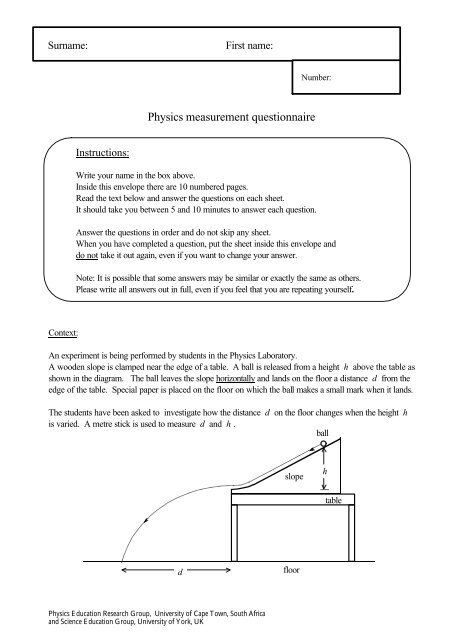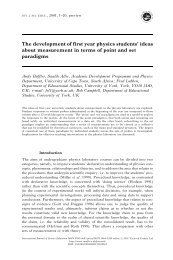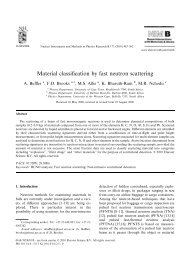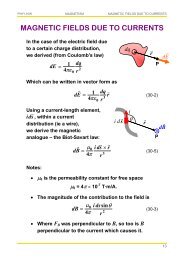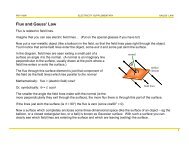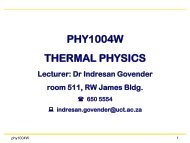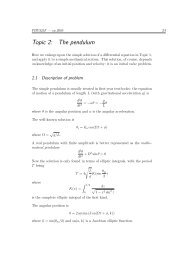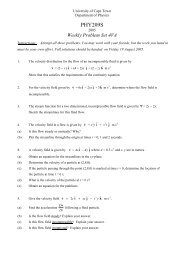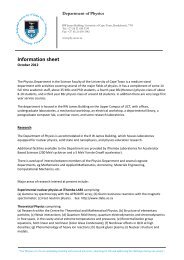The PMQ probes - University of Cape Town
The PMQ probes - University of Cape Town
The PMQ probes - University of Cape Town
You also want an ePaper? Increase the reach of your titles
YUMPU automatically turns print PDFs into web optimized ePapers that Google loves.
Surname:<br />
First name:<br />
Number:<br />
Physics measurement questionnaire<br />
Instructions:<br />
Write your name in the box above.<br />
Inside this envelope there are 10 numbered pages.<br />
Read the text below and answer the questions on each sheet.<br />
It should take you between 5 and 10 minutes to answer each question.<br />
Answer the questions in order and do not skip any sheet.<br />
When you have completed a question, put the sheet inside this envelope and<br />
do not take it out again, even if you want to change your answer.<br />
Note: It is possible that some answers may be similar or exactly the same as others.<br />
Please write all answers out in full, even if you feel that you are repeating yourself.<br />
Context:<br />
An experiment is being performed by students in the Physics Laboratory.<br />
A wooden slope is clamped near the edge <strong>of</strong> a table. A ball is released from a height h above the table as<br />
shown in the diagram. <strong>The</strong> ball leaves the slope horizontally and lands on the floor a distance d from the<br />
edge <strong>of</strong> the table. Special paper is placed on the floor on which the ball makes a small mark when it lands.<br />
<strong>The</strong> students have been asked to investigate how the distance d on the floor changes when the height h<br />
is varied. A metre stick is used to measure d and h .<br />
ball<br />
slope<br />
h<br />
table<br />
d<br />
floor<br />
Physics Education Research Group, <strong>University</strong> <strong>of</strong> <strong>Cape</strong> <strong>Town</strong>, South Africa<br />
and Science Education Group, <strong>University</strong> <strong>of</strong> York, UK
Physics measurement questionnaire<br />
Number:<br />
Q 1.<br />
(RD)<br />
<strong>The</strong> students work in groups on the experiment. <strong>The</strong>ir first task is to determine d when<br />
h = 400 mm. One group releases the ball down the slope at a height h = 400 mm and,<br />
using a metre stick, they measure d to be 436 mm.<br />
<strong>The</strong> following discussion then takes place between the students.<br />
I think we should<br />
roll the ball a few<br />
more times from<br />
the same height and<br />
measure d each<br />
time.<br />
Why? We’ve got<br />
the result already.<br />
We do not need<br />
to do any more<br />
rolling.<br />
I think we<br />
should roll the<br />
ball down the<br />
slope just one<br />
more time<br />
from the<br />
same height.<br />
A B C<br />
With whom do you most closely agree? (Circle ONE):<br />
A<br />
B<br />
C<br />
Explain your choice.<br />
_______________________________________________________________________________<br />
_______________________________________________________________________________<br />
_______________________________________________________________________________<br />
_______________________________________________________________________________<br />
_______________________________________________________________________________<br />
_______________________________________________________________________________<br />
_______________________________________________________________________________<br />
_______________________________________________________________________________<br />
Physics Education Research Group, <strong>University</strong> <strong>of</strong> <strong>Cape</strong> <strong>Town</strong>, South Africa<br />
and Science Education Group, <strong>University</strong> <strong>of</strong> York, UK
Physics measurement questionnaire<br />
Number:<br />
Q 2.<br />
(RDA)<br />
<strong>The</strong> group <strong>of</strong> students decide to release the ball again from h = 400 mm.<br />
This time they measure d = 426 mm.<br />
First release: h = 400 mm d = 436 mm<br />
Second release: h = 400 mm d = 426 mm<br />
<strong>The</strong> following discussion then takes place between the students.<br />
We know<br />
enough.<br />
We don’t need to<br />
repeat the<br />
measurement<br />
again.<br />
We need to<br />
release the<br />
ball just one<br />
more time.<br />
Three releases<br />
will not be<br />
enough.<br />
We should<br />
release the ball<br />
several more<br />
times.<br />
A B C<br />
With whom do you most closely agree? (Circle ONE):<br />
A<br />
B<br />
C<br />
Explain your choice.<br />
_______________________________________________________________________________<br />
_______________________________________________________________________________<br />
_______________________________________________________________________________<br />
_______________________________________________________________________________<br />
_______________________________________________________________________________<br />
_______________________________________________________________________________<br />
_______________________________________________________________________________<br />
Physics Education Research Group, <strong>University</strong> <strong>of</strong> <strong>Cape</strong> <strong>Town</strong>, South Africa<br />
and Science Education Group, <strong>University</strong> <strong>of</strong> York, UK
Physics measurement questionnaire<br />
Number:<br />
Q 3.<br />
(UR)<br />
<strong>The</strong> students continue to release the ball down the slope at a height h = 400 mm.<br />
<strong>The</strong>ir results after five releases are:<br />
Release d (mm)<br />
1 436<br />
2 425<br />
3 440<br />
4 425<br />
5 434<br />
<strong>The</strong> students then discuss what to write down for d as their final result.<br />
I wonder what we<br />
should write down as<br />
our final result for d.<br />
Write down what you think the students should<br />
record as their final result for d.<br />
Explain your choice.<br />
_______________________________________________________________________________<br />
_______________________________________________________________________________<br />
_______________________________________________________________________________<br />
_______________________________________________________________________________<br />
_______________________________________________________________________________<br />
_______________________________________________________________________________<br />
Physics Education Research Group, <strong>University</strong> <strong>of</strong> <strong>Cape</strong> <strong>Town</strong>, South Africa<br />
and Science Education Group, <strong>University</strong> <strong>of</strong> York, UK
Physics measurement questionnaire<br />
Number:<br />
Q 4.<br />
(AN)<br />
Another group <strong>of</strong> students have decided to calculate the average <strong>of</strong> all their measurements <strong>of</strong> d for<br />
h = 400 mm. <strong>The</strong>ir results after six releases are:<br />
Release d (mm)<br />
1 443<br />
2 422<br />
3 436<br />
4 588<br />
5 437<br />
6 429<br />
<strong>The</strong> students then discuss what to write down for the average <strong>of</strong> d .<br />
All we need to do is<br />
to add all our<br />
measurements and then<br />
divide by 6.<br />
No. We should<br />
ignore d = 588 mm<br />
and then add the rest<br />
and divide by 5.<br />
A<br />
B<br />
With whom do you most closely agree? (Circle ONE):<br />
A<br />
B<br />
Explain your choice.<br />
_______________________________________________________________________________<br />
_______________________________________________________________________________<br />
_______________________________________________________________________________<br />
_______________________________________________________________________________<br />
_______________________________________________________________________________<br />
Physics Education Research Group, <strong>University</strong> <strong>of</strong> <strong>Cape</strong> <strong>Town</strong>, South Africa<br />
and Science Education Group, <strong>University</strong> <strong>of</strong> York, UK
Physics measurement questionnaire<br />
Number:<br />
Q 5.<br />
(SMDS)<br />
Two groups <strong>of</strong> students compare their results for d obtained by releasing the ball at h = 400 mm. <strong>The</strong>ir<br />
results for five releases are shown below.<br />
Group A<br />
Group B<br />
Release d (mm) d (mm)<br />
1 444 441<br />
2 432 460<br />
3 424 410<br />
4 440 424<br />
5 435 440<br />
Average: 435 435<br />
Our results are better.<br />
<strong>The</strong>y are all between<br />
424 mm and 444 mm.<br />
Yours are spread<br />
between 410 mm<br />
and 460 mm.<br />
Our results are just<br />
as good as yours.<br />
Our average is the<br />
same as yours.<br />
We both got<br />
435 mm for d.<br />
I think the<br />
results <strong>of</strong><br />
group B are<br />
better than<br />
the results<br />
<strong>of</strong> group A.<br />
A B C<br />
With which group do you most closely agree? (Circle ONE):<br />
A<br />
B<br />
C<br />
Explain your choice.<br />
_______________________________________________________________________________<br />
_______________________________________________________________________________<br />
_______________________________________________________________________________<br />
_______________________________________________________________________________<br />
Physics Education Research Group, <strong>University</strong> <strong>of</strong> <strong>Cape</strong> <strong>Town</strong>, South Africa<br />
and Science Education Group, <strong>University</strong> <strong>of</strong> York, UK
Physics measurement questionnaire<br />
Number:<br />
Q 6.<br />
(DMSS)<br />
Two other groups <strong>of</strong> students compare their results for d obtained by releasing the ball<br />
at h = 400 mm. <strong>The</strong>ir results for five releases are shown below.<br />
Group A<br />
Group B<br />
Release d (mm) d (mm)<br />
1 440 432<br />
2 438 444<br />
3 433 426<br />
4 422 433<br />
5 432 440<br />
Average: 433 435<br />
Our result agrees<br />
with yours.<br />
No, your result<br />
does not agree<br />
with ours.<br />
A<br />
B<br />
With which group do you most closely agree? (Circle ONE):<br />
A<br />
B<br />
Explain your choice.<br />
_______________________________________________________________________________<br />
_______________________________________________________________________________<br />
_______________________________________________________________________________<br />
_______________________________________________________________________________<br />
_______________________________________________________________________________<br />
_______________________________________________________________________________<br />
Physics Education Research Group, <strong>University</strong> <strong>of</strong> <strong>Cape</strong> <strong>Town</strong>, South Africa<br />
and Science Education Group, <strong>University</strong> <strong>of</strong> York, UK
Physics measurement questionnaire<br />
Number:<br />
Q 7.<br />
(RT)<br />
<strong>The</strong> students are now given a stopwatch and are asked to measure the time that the ball takes from the<br />
edge <strong>of</strong> the table to hitting the ground after being released at h = 400 mm.<br />
<strong>The</strong>y discuss what to do.<br />
We can roll the<br />
ball once from<br />
h = 400 mm<br />
and measure<br />
the time.<br />
Once is enough.<br />
Let’s roll the ball<br />
twice from height h<br />
= 400 mm, and<br />
measure the time for<br />
each case.<br />
I think we should<br />
release the ball<br />
more than twice<br />
from h = 400 mm<br />
and measure the<br />
time in each case.<br />
A B C<br />
With whom do you most closely agree? (Circle ONE):<br />
A<br />
B<br />
C<br />
Explain your choice.<br />
_______________________________________________________________________________<br />
_______________________________________________________________________________<br />
_______________________________________________________________________________<br />
_______________________________________________________________________________<br />
_______________________________________________________________________________<br />
_______________________________________________________________________________<br />
_______________________________________________________________________________<br />
_______________________________________________________________________________<br />
Physics Education Research Group, <strong>University</strong> <strong>of</strong> <strong>Cape</strong> <strong>Town</strong>, South Africa<br />
and Science Education Group, <strong>University</strong> <strong>of</strong> York, UK
Physics measurement questionnaire<br />
Number:<br />
Q 8.<br />
(IR)<br />
<strong>The</strong> students now need to investigate how d changes as the height <strong>of</strong> release h is varied. <strong>The</strong> ball can be<br />
released from the following heights:<br />
100 mm , 200 mm , 300 mm , 400 mm , 500 mm , 600 mm , 700 mm , 800 mm , 900 mm<br />
If they had enough time, one strategy would be to release the ball from each <strong>of</strong> these heights.<br />
As they only have enough time to make measurements at four different heights, they have to decide on<br />
which four heights to choose.<br />
We should release the<br />
ball at heights<br />
100 mm , 200 mm ,<br />
300 mm and<br />
400 mm.<br />
No, we should<br />
release the ball at<br />
heights 200 mm ,<br />
400 mm , 600 mm<br />
and 800 mm.<br />
I think that we should<br />
release the ball at<br />
heights<br />
100 mm , 400 mm ,<br />
600 mm and<br />
900 mm.<br />
A B C<br />
With whom do you most closely agree? (Circle ONE):<br />
A<br />
B<br />
C<br />
Explain your choice.<br />
_______________________________________________________________________________<br />
_______________________________________________________________________________<br />
_______________________________________________________________________________<br />
_______________________________________________________________________________<br />
_______________________________________________________________________________<br />
_______________________________________________________________________________<br />
Physics Education Research Group, <strong>University</strong> <strong>of</strong> <strong>Cape</strong> <strong>Town</strong>, South Africa<br />
and Science Education Group, <strong>University</strong> <strong>of</strong> York, UK
Physics measurement questionnaire<br />
Number:<br />
Q 9.<br />
(SLG)<br />
A group <strong>of</strong> students collect data at different heights and use it to plot a straight line graph. <strong>The</strong> data are<br />
plotted below. On this graph, draw the line that you think best fits this data.<br />
d<br />
¤<br />
¤<br />
¤<br />
¤<br />
¤<br />
¤<br />
¤<br />
t<br />
Explain carefully what you have done and why.<br />
_______________________________________________________________________________<br />
_______________________________________________________________________________<br />
_______________________________________________________________________________<br />
_______________________________________________________________________________<br />
_______________________________________________________________________________<br />
_______________________________________________________________________________<br />
_______________________________________________________________________________<br />
_______________________________________________________________________________<br />
_______________________________________________________________________________<br />
Physics Education Research Group, <strong>University</strong> <strong>of</strong> <strong>Cape</strong> <strong>Town</strong>, South Africa<br />
and Science Education Group, <strong>University</strong> <strong>of</strong> York, UK
Physics measurement questionnaire<br />
Number:<br />
Q 10.<br />
Comments.<br />
Are there any answers to the previous question sheets that you want to change?<br />
Please do not remove any sheets from the envelope.<br />
What was the question about and how do you want to change your answer?<br />
_________________________________________________________________<br />
_______________________________________________________________________________<br />
_______________________________________________________________________________<br />
_______________________________________________________________________________<br />
_______________________________________________________________________________<br />
_______________________________________________________________________________<br />
_______________________________________________________________________________<br />
_______________________________________________________________________________<br />
_______________________________________________________________________________<br />
Any other comments?<br />
_______________________________________________________________________________<br />
_______________________________________________________________________________<br />
_______________________________________________________________________________<br />
_______________________________________________________________________________<br />
_______________________________________________________________________________<br />
In this questionnaire, I thought<br />
that the cartoon figures were (tick one): male female<br />
no<br />
gender<br />
Physics Education Research Group, <strong>University</strong> <strong>of</strong> <strong>Cape</strong> <strong>Town</strong>, South Africa<br />
and Science Education Group, <strong>University</strong> <strong>of</strong> York, UK


